Elements of Negligence and Importance in Professional Life
VerifiedAdded on 2022/11/13
|10
|2507
|365
AI Summary
This report discusses the elements of negligence and the importance of negligence in professional life. It covers the duty of care, breach of duty of care, harm caused because of breach of duty, and more.
Contribute Materials
Your contribution can guide someone’s learning journey. Share your
documents today.
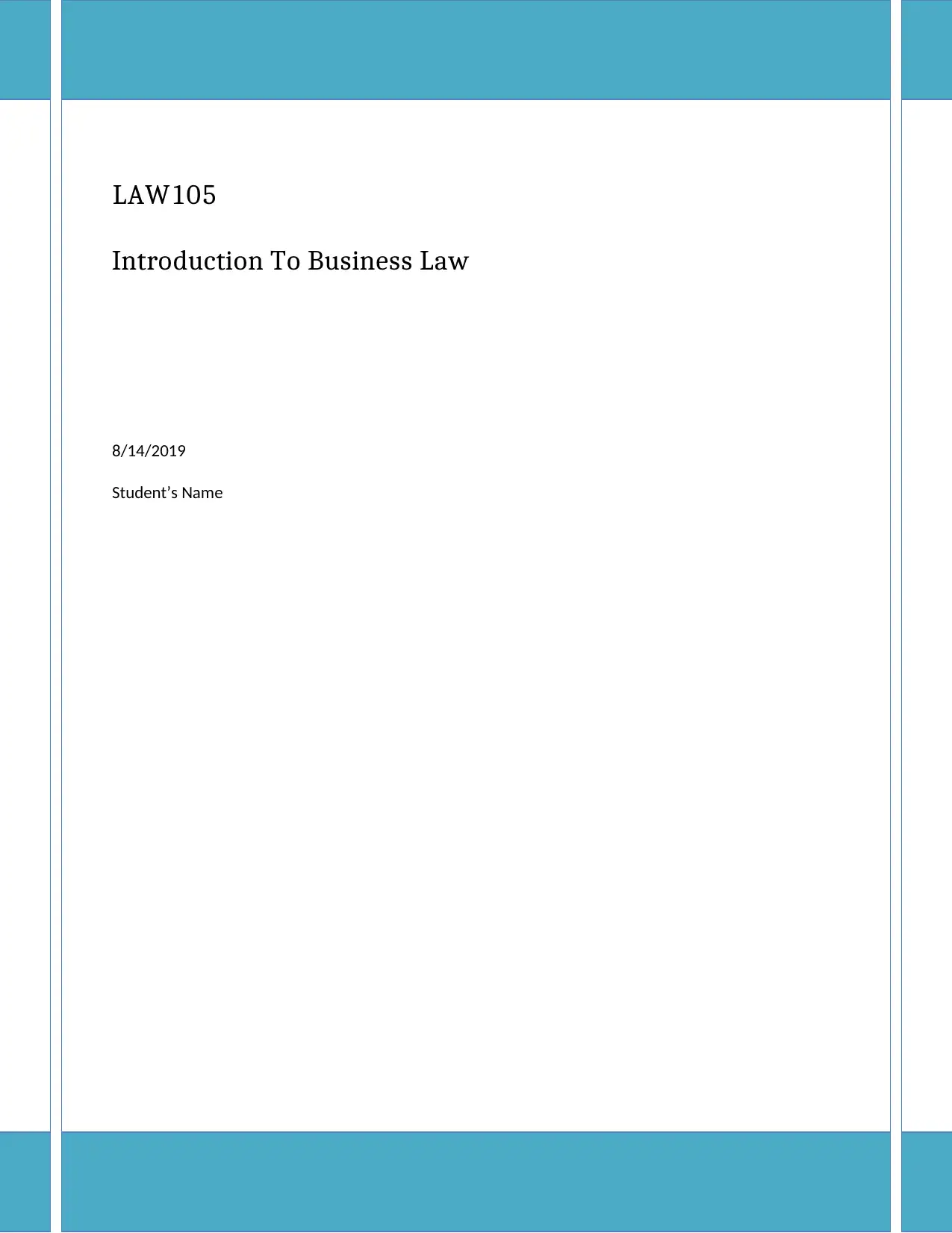
Running Head: BUSINESS AND CORPORATION LAW 0
LAW105
Introduction To Business Law
8/14/2019
Student’s Name
LAW105
Introduction To Business Law
8/14/2019
Student’s Name
Secure Best Marks with AI Grader
Need help grading? Try our AI Grader for instant feedback on your assignments.
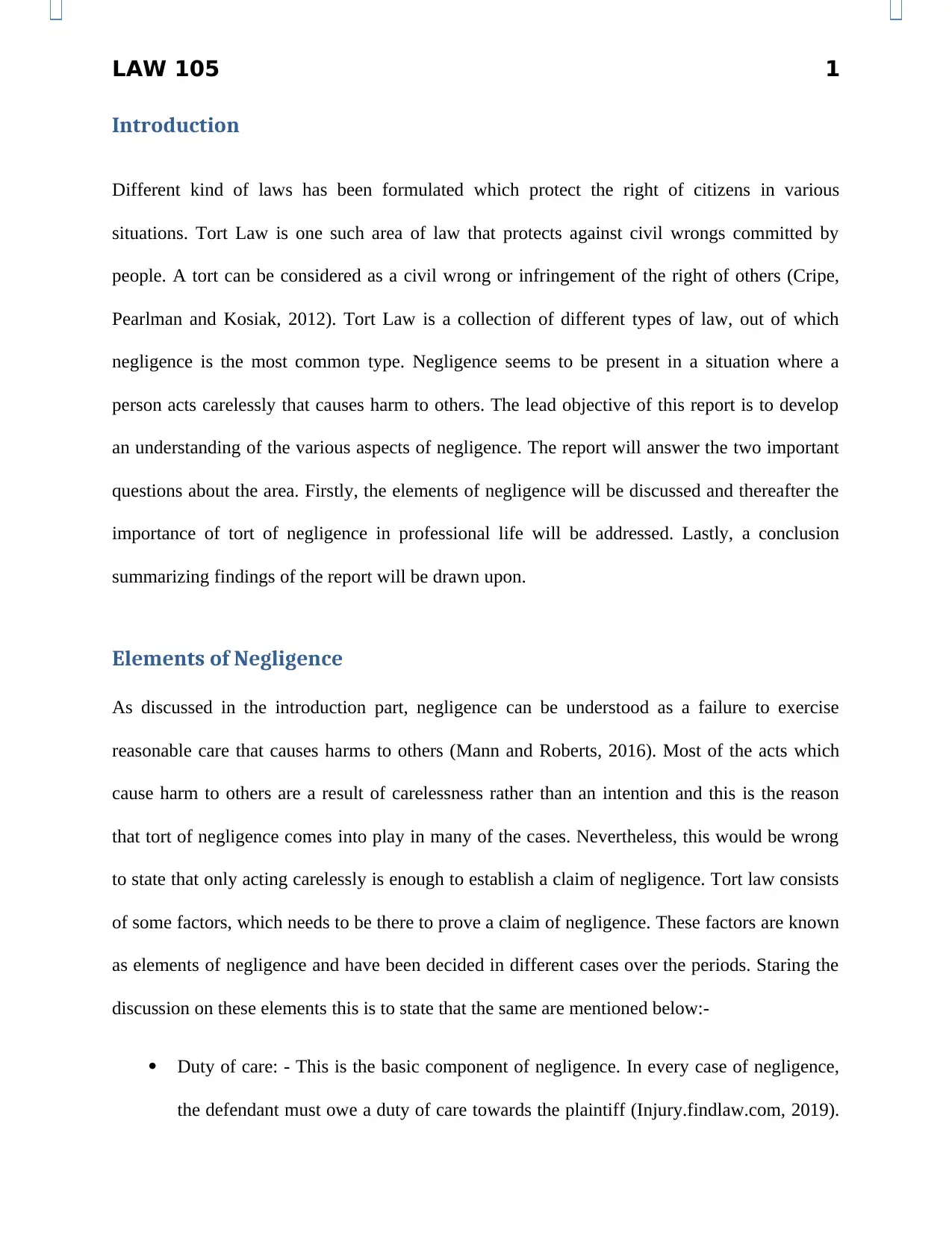
LAW 105 1
Introduction
Different kind of laws has been formulated which protect the right of citizens in various
situations. Tort Law is one such area of law that protects against civil wrongs committed by
people. A tort can be considered as a civil wrong or infringement of the right of others (Cripe,
Pearlman and Kosiak, 2012). Tort Law is a collection of different types of law, out of which
negligence is the most common type. Negligence seems to be present in a situation where a
person acts carelessly that causes harm to others. The lead objective of this report is to develop
an understanding of the various aspects of negligence. The report will answer the two important
questions about the area. Firstly, the elements of negligence will be discussed and thereafter the
importance of tort of negligence in professional life will be addressed. Lastly, a conclusion
summarizing findings of the report will be drawn upon.
Elements of Negligence
As discussed in the introduction part, negligence can be understood as a failure to exercise
reasonable care that causes harms to others (Mann and Roberts, 2016). Most of the acts which
cause harm to others are a result of carelessness rather than an intention and this is the reason
that tort of negligence comes into play in many of the cases. Nevertheless, this would be wrong
to state that only acting carelessly is enough to establish a claim of negligence. Tort law consists
of some factors, which needs to be there to prove a claim of negligence. These factors are known
as elements of negligence and have been decided in different cases over the periods. Staring the
discussion on these elements this is to state that the same are mentioned below:-
Duty of care: - This is the basic component of negligence. In every case of negligence,
the defendant must owe a duty of care towards the plaintiff (Injury.findlaw.com, 2019).
Introduction
Different kind of laws has been formulated which protect the right of citizens in various
situations. Tort Law is one such area of law that protects against civil wrongs committed by
people. A tort can be considered as a civil wrong or infringement of the right of others (Cripe,
Pearlman and Kosiak, 2012). Tort Law is a collection of different types of law, out of which
negligence is the most common type. Negligence seems to be present in a situation where a
person acts carelessly that causes harm to others. The lead objective of this report is to develop
an understanding of the various aspects of negligence. The report will answer the two important
questions about the area. Firstly, the elements of negligence will be discussed and thereafter the
importance of tort of negligence in professional life will be addressed. Lastly, a conclusion
summarizing findings of the report will be drawn upon.
Elements of Negligence
As discussed in the introduction part, negligence can be understood as a failure to exercise
reasonable care that causes harms to others (Mann and Roberts, 2016). Most of the acts which
cause harm to others are a result of carelessness rather than an intention and this is the reason
that tort of negligence comes into play in many of the cases. Nevertheless, this would be wrong
to state that only acting carelessly is enough to establish a claim of negligence. Tort law consists
of some factors, which needs to be there to prove a claim of negligence. These factors are known
as elements of negligence and have been decided in different cases over the periods. Staring the
discussion on these elements this is to state that the same are mentioned below:-
Duty of care: - This is the basic component of negligence. In every case of negligence,
the defendant must owe a duty of care towards the plaintiff (Injury.findlaw.com, 2019).
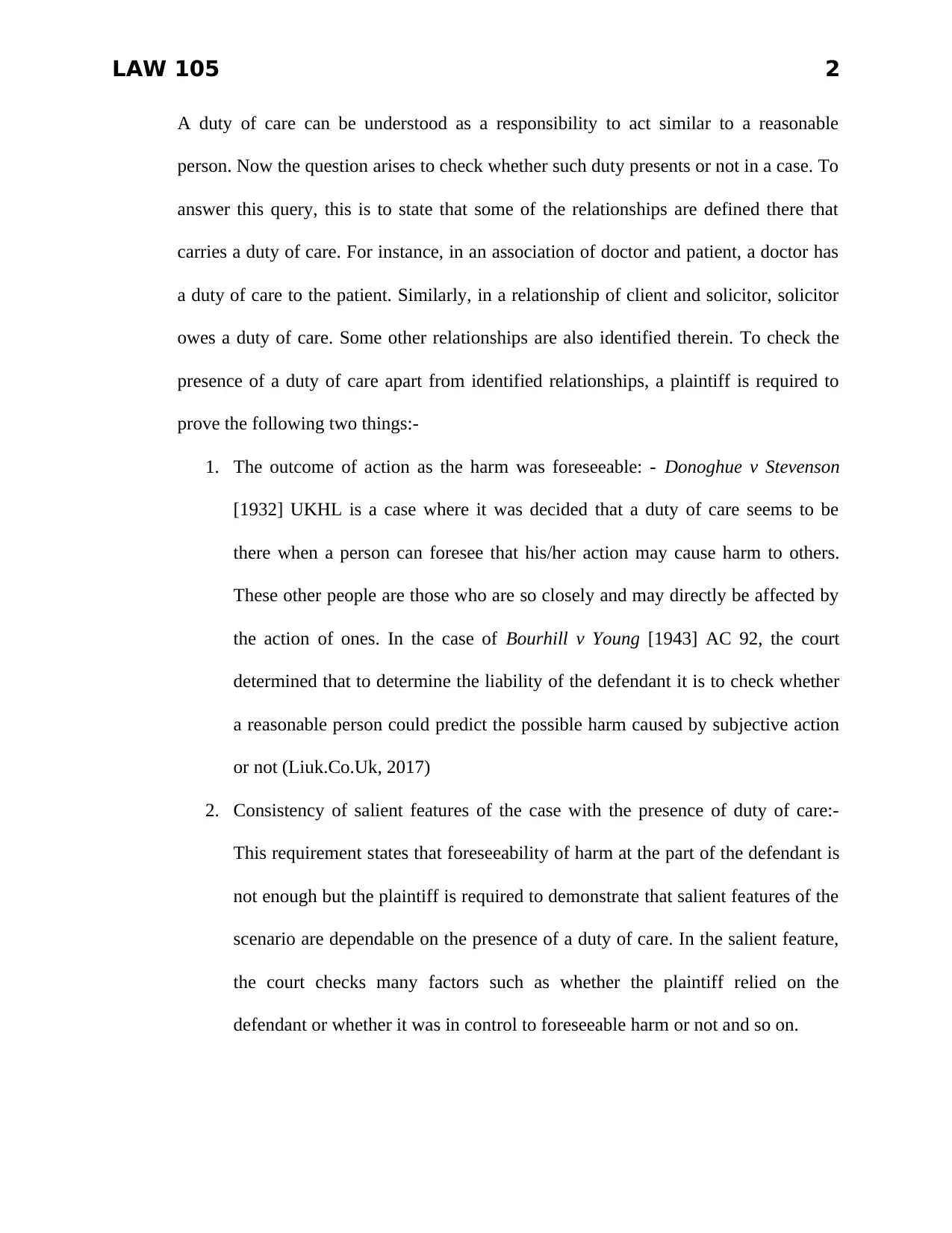
LAW 105 2
A duty of care can be understood as a responsibility to act similar to a reasonable
person. Now the question arises to check whether such duty presents or not in a case. To
answer this query, this is to state that some of the relationships are defined there that
carries a duty of care. For instance, in an association of doctor and patient, a doctor has
a duty of care to the patient. Similarly, in a relationship of client and solicitor, solicitor
owes a duty of care. Some other relationships are also identified therein. To check the
presence of a duty of care apart from identified relationships, a plaintiff is required to
prove the following two things:-
1. The outcome of action as the harm was foreseeable: - Donoghue v Stevenson
[1932] UKHL is a case where it was decided that a duty of care seems to be
there when a person can foresee that his/her action may cause harm to others.
These other people are those who are so closely and may directly be affected by
the action of ones. In the case of Bourhill v Young [1943] AC 92, the court
determined that to determine the liability of the defendant it is to check whether
a reasonable person could predict the possible harm caused by subjective action
or not (Liuk.Co.Uk, 2017)
2. Consistency of salient features of the case with the presence of duty of care:-
This requirement states that foreseeability of harm at the part of the defendant is
not enough but the plaintiff is required to demonstrate that salient features of the
scenario are dependable on the presence of a duty of care. In the salient feature,
the court checks many factors such as whether the plaintiff relied on the
defendant or whether it was in control to foreseeable harm or not and so on.
A duty of care can be understood as a responsibility to act similar to a reasonable
person. Now the question arises to check whether such duty presents or not in a case. To
answer this query, this is to state that some of the relationships are defined there that
carries a duty of care. For instance, in an association of doctor and patient, a doctor has
a duty of care to the patient. Similarly, in a relationship of client and solicitor, solicitor
owes a duty of care. Some other relationships are also identified therein. To check the
presence of a duty of care apart from identified relationships, a plaintiff is required to
prove the following two things:-
1. The outcome of action as the harm was foreseeable: - Donoghue v Stevenson
[1932] UKHL is a case where it was decided that a duty of care seems to be
there when a person can foresee that his/her action may cause harm to others.
These other people are those who are so closely and may directly be affected by
the action of ones. In the case of Bourhill v Young [1943] AC 92, the court
determined that to determine the liability of the defendant it is to check whether
a reasonable person could predict the possible harm caused by subjective action
or not (Liuk.Co.Uk, 2017)
2. Consistency of salient features of the case with the presence of duty of care:-
This requirement states that foreseeability of harm at the part of the defendant is
not enough but the plaintiff is required to demonstrate that salient features of the
scenario are dependable on the presence of a duty of care. In the salient feature,
the court checks many factors such as whether the plaintiff relied on the
defendant or whether it was in control to foreseeable harm or not and so on.
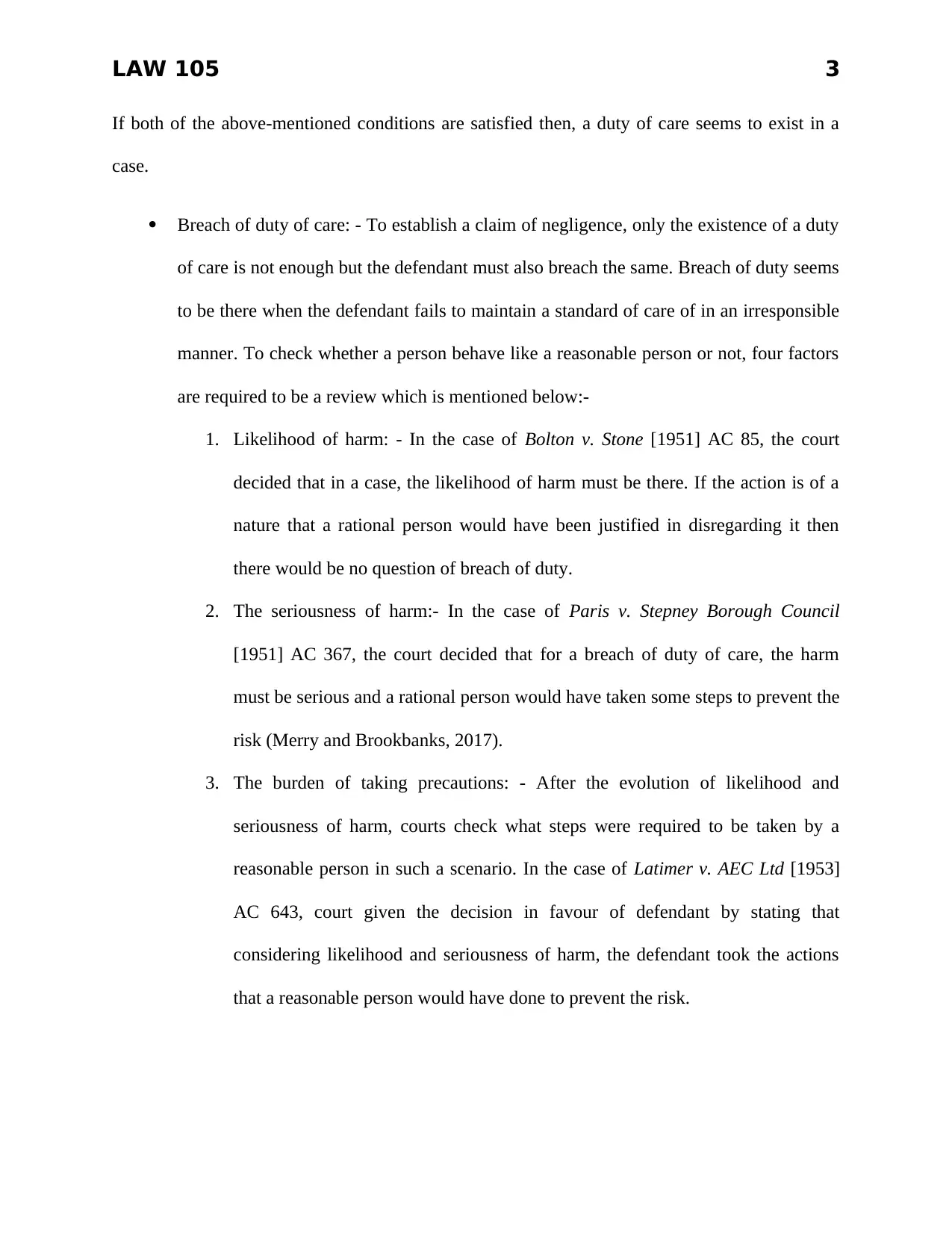
LAW 105 3
If both of the above-mentioned conditions are satisfied then, a duty of care seems to exist in a
case.
Breach of duty of care: - To establish a claim of negligence, only the existence of a duty
of care is not enough but the defendant must also breach the same. Breach of duty seems
to be there when the defendant fails to maintain a standard of care of in an irresponsible
manner. To check whether a person behave like a reasonable person or not, four factors
are required to be a review which is mentioned below:-
1. Likelihood of harm: - In the case of Bolton v. Stone [1951] AC 85, the court
decided that in a case, the likelihood of harm must be there. If the action is of a
nature that a rational person would have been justified in disregarding it then
there would be no question of breach of duty.
2. The seriousness of harm:- In the case of Paris v. Stepney Borough Council
[1951] AC 367, the court decided that for a breach of duty of care, the harm
must be serious and a rational person would have taken some steps to prevent the
risk (Merry and Brookbanks, 2017).
3. The burden of taking precautions: - After the evolution of likelihood and
seriousness of harm, courts check what steps were required to be taken by a
reasonable person in such a scenario. In the case of Latimer v. AEC Ltd [1953]
AC 643, court given the decision in favour of defendant by stating that
considering likelihood and seriousness of harm, the defendant took the actions
that a reasonable person would have done to prevent the risk.
If both of the above-mentioned conditions are satisfied then, a duty of care seems to exist in a
case.
Breach of duty of care: - To establish a claim of negligence, only the existence of a duty
of care is not enough but the defendant must also breach the same. Breach of duty seems
to be there when the defendant fails to maintain a standard of care of in an irresponsible
manner. To check whether a person behave like a reasonable person or not, four factors
are required to be a review which is mentioned below:-
1. Likelihood of harm: - In the case of Bolton v. Stone [1951] AC 85, the court
decided that in a case, the likelihood of harm must be there. If the action is of a
nature that a rational person would have been justified in disregarding it then
there would be no question of breach of duty.
2. The seriousness of harm:- In the case of Paris v. Stepney Borough Council
[1951] AC 367, the court decided that for a breach of duty of care, the harm
must be serious and a rational person would have taken some steps to prevent the
risk (Merry and Brookbanks, 2017).
3. The burden of taking precautions: - After the evolution of likelihood and
seriousness of harm, courts check what steps were required to be taken by a
reasonable person in such a scenario. In the case of Latimer v. AEC Ltd [1953]
AC 643, court given the decision in favour of defendant by stating that
considering likelihood and seriousness of harm, the defendant took the actions
that a reasonable person would have done to prevent the risk.
Secure Best Marks with AI Grader
Need help grading? Try our AI Grader for instant feedback on your assignments.
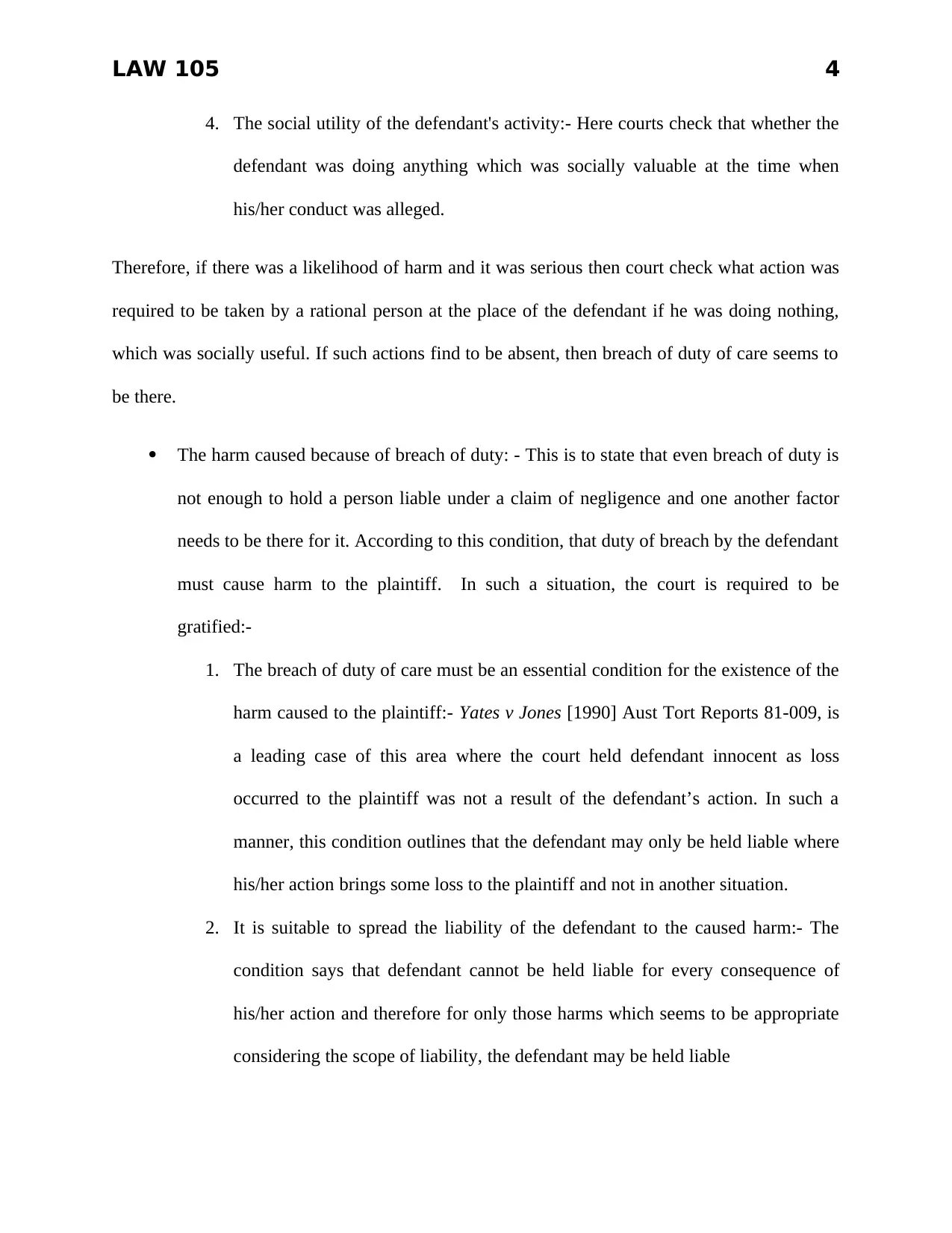
LAW 105 4
4. The social utility of the defendant's activity:- Here courts check that whether the
defendant was doing anything which was socially valuable at the time when
his/her conduct was alleged.
Therefore, if there was a likelihood of harm and it was serious then court check what action was
required to be taken by a rational person at the place of the defendant if he was doing nothing,
which was socially useful. If such actions find to be absent, then breach of duty of care seems to
be there.
The harm caused because of breach of duty: - This is to state that even breach of duty is
not enough to hold a person liable under a claim of negligence and one another factor
needs to be there for it. According to this condition, that duty of breach by the defendant
must cause harm to the plaintiff. In such a situation, the court is required to be
gratified:-
1. The breach of duty of care must be an essential condition for the existence of the
harm caused to the plaintiff:- Yates v Jones [1990] Aust Tort Reports 81-009, is
a leading case of this area where the court held defendant innocent as loss
occurred to the plaintiff was not a result of the defendant’s action. In such a
manner, this condition outlines that the defendant may only be held liable where
his/her action brings some loss to the plaintiff and not in another situation.
2. It is suitable to spread the liability of the defendant to the caused harm:- The
condition says that defendant cannot be held liable for every consequence of
his/her action and therefore for only those harms which seems to be appropriate
considering the scope of liability, the defendant may be held liable
4. The social utility of the defendant's activity:- Here courts check that whether the
defendant was doing anything which was socially valuable at the time when
his/her conduct was alleged.
Therefore, if there was a likelihood of harm and it was serious then court check what action was
required to be taken by a rational person at the place of the defendant if he was doing nothing,
which was socially useful. If such actions find to be absent, then breach of duty of care seems to
be there.
The harm caused because of breach of duty: - This is to state that even breach of duty is
not enough to hold a person liable under a claim of negligence and one another factor
needs to be there for it. According to this condition, that duty of breach by the defendant
must cause harm to the plaintiff. In such a situation, the court is required to be
gratified:-
1. The breach of duty of care must be an essential condition for the existence of the
harm caused to the plaintiff:- Yates v Jones [1990] Aust Tort Reports 81-009, is
a leading case of this area where the court held defendant innocent as loss
occurred to the plaintiff was not a result of the defendant’s action. In such a
manner, this condition outlines that the defendant may only be held liable where
his/her action brings some loss to the plaintiff and not in another situation.
2. It is suitable to spread the liability of the defendant to the caused harm:- The
condition says that defendant cannot be held liable for every consequence of
his/her action and therefore for only those harms which seems to be appropriate
considering the scope of liability, the defendant may be held liable
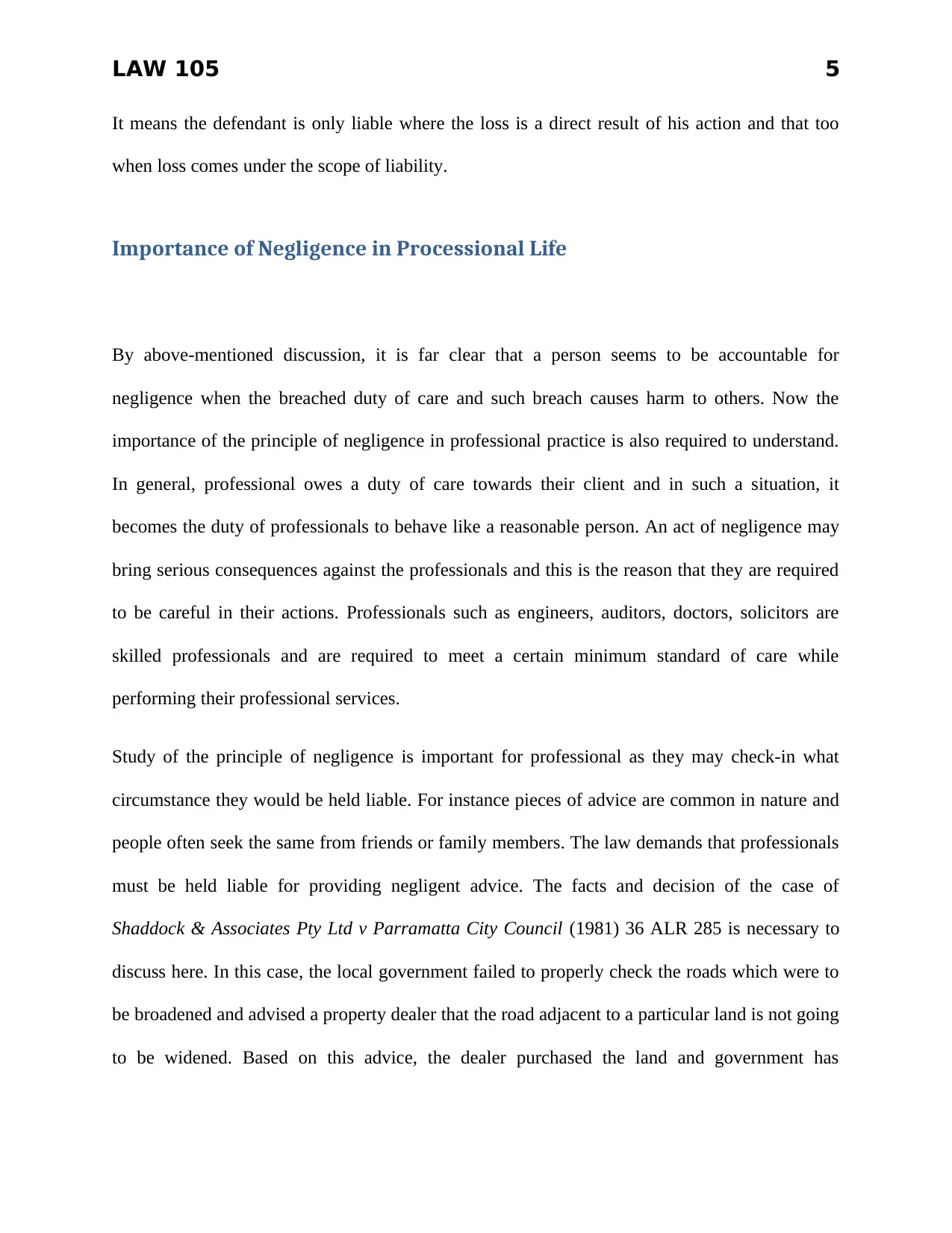
LAW 105 5
It means the defendant is only liable where the loss is a direct result of his action and that too
when loss comes under the scope of liability.
Importance of Negligence in Processional Life
By above-mentioned discussion, it is far clear that a person seems to be accountable for
negligence when the breached duty of care and such breach causes harm to others. Now the
importance of the principle of negligence in professional practice is also required to understand.
In general, professional owes a duty of care towards their client and in such a situation, it
becomes the duty of professionals to behave like a reasonable person. An act of negligence may
bring serious consequences against the professionals and this is the reason that they are required
to be careful in their actions. Professionals such as engineers, auditors, doctors, solicitors are
skilled professionals and are required to meet a certain minimum standard of care while
performing their professional services.
Study of the principle of negligence is important for professional as they may check-in what
circumstance they would be held liable. For instance pieces of advice are common in nature and
people often seek the same from friends or family members. The law demands that professionals
must be held liable for providing negligent advice. The facts and decision of the case of
Shaddock & Associates Pty Ltd v Parramatta City Council (1981) 36 ALR 285 is necessary to
discuss here. In this case, the local government failed to properly check the roads which were to
be broadened and advised a property dealer that the road adjacent to a particular land is not going
to be widened. Based on this advice, the dealer purchased the land and government has
It means the defendant is only liable where the loss is a direct result of his action and that too
when loss comes under the scope of liability.
Importance of Negligence in Processional Life
By above-mentioned discussion, it is far clear that a person seems to be accountable for
negligence when the breached duty of care and such breach causes harm to others. Now the
importance of the principle of negligence in professional practice is also required to understand.
In general, professional owes a duty of care towards their client and in such a situation, it
becomes the duty of professionals to behave like a reasonable person. An act of negligence may
bring serious consequences against the professionals and this is the reason that they are required
to be careful in their actions. Professionals such as engineers, auditors, doctors, solicitors are
skilled professionals and are required to meet a certain minimum standard of care while
performing their professional services.
Study of the principle of negligence is important for professional as they may check-in what
circumstance they would be held liable. For instance pieces of advice are common in nature and
people often seek the same from friends or family members. The law demands that professionals
must be held liable for providing negligent advice. The facts and decision of the case of
Shaddock & Associates Pty Ltd v Parramatta City Council (1981) 36 ALR 285 is necessary to
discuss here. In this case, the local government failed to properly check the roads which were to
be broadened and advised a property dealer that the road adjacent to a particular land is not going
to be widened. Based on this advice, the dealer purchased the land and government has
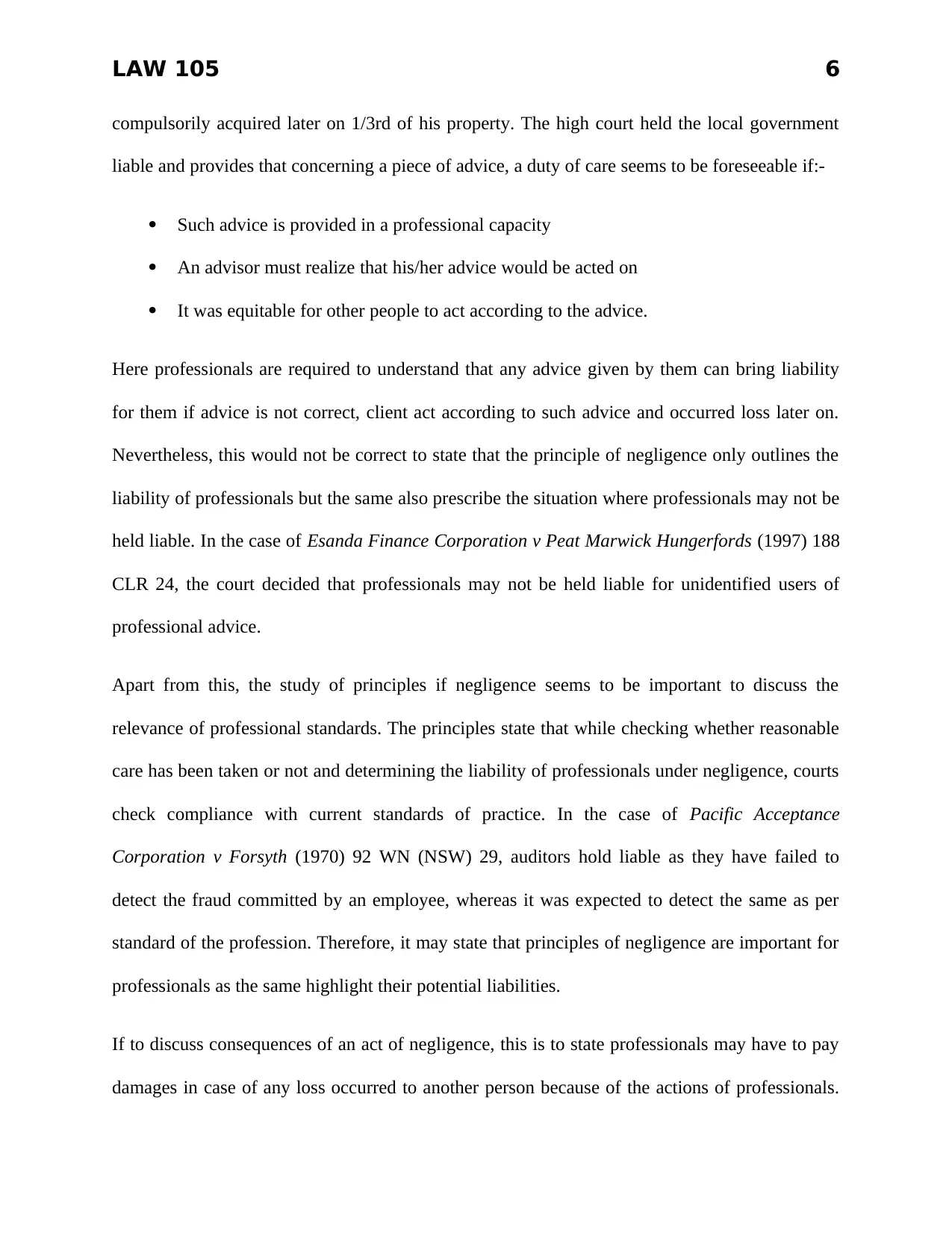
LAW 105 6
compulsorily acquired later on 1/3rd of his property. The high court held the local government
liable and provides that concerning a piece of advice, a duty of care seems to be foreseeable if:-
Such advice is provided in a professional capacity
An advisor must realize that his/her advice would be acted on
It was equitable for other people to act according to the advice.
Here professionals are required to understand that any advice given by them can bring liability
for them if advice is not correct, client act according to such advice and occurred loss later on.
Nevertheless, this would not be correct to state that the principle of negligence only outlines the
liability of professionals but the same also prescribe the situation where professionals may not be
held liable. In the case of Esanda Finance Corporation v Peat Marwick Hungerfords (1997) 188
CLR 24, the court decided that professionals may not be held liable for unidentified users of
professional advice.
Apart from this, the study of principles if negligence seems to be important to discuss the
relevance of professional standards. The principles state that while checking whether reasonable
care has been taken or not and determining the liability of professionals under negligence, courts
check compliance with current standards of practice. In the case of Pacific Acceptance
Corporation v Forsyth (1970) 92 WN (NSW) 29, auditors hold liable as they have failed to
detect the fraud committed by an employee, whereas it was expected to detect the same as per
standard of the profession. Therefore, it may state that principles of negligence are important for
professionals as the same highlight their potential liabilities.
If to discuss consequences of an act of negligence, this is to state professionals may have to pay
damages in case of any loss occurred to another person because of the actions of professionals.
compulsorily acquired later on 1/3rd of his property. The high court held the local government
liable and provides that concerning a piece of advice, a duty of care seems to be foreseeable if:-
Such advice is provided in a professional capacity
An advisor must realize that his/her advice would be acted on
It was equitable for other people to act according to the advice.
Here professionals are required to understand that any advice given by them can bring liability
for them if advice is not correct, client act according to such advice and occurred loss later on.
Nevertheless, this would not be correct to state that the principle of negligence only outlines the
liability of professionals but the same also prescribe the situation where professionals may not be
held liable. In the case of Esanda Finance Corporation v Peat Marwick Hungerfords (1997) 188
CLR 24, the court decided that professionals may not be held liable for unidentified users of
professional advice.
Apart from this, the study of principles if negligence seems to be important to discuss the
relevance of professional standards. The principles state that while checking whether reasonable
care has been taken or not and determining the liability of professionals under negligence, courts
check compliance with current standards of practice. In the case of Pacific Acceptance
Corporation v Forsyth (1970) 92 WN (NSW) 29, auditors hold liable as they have failed to
detect the fraud committed by an employee, whereas it was expected to detect the same as per
standard of the profession. Therefore, it may state that principles of negligence are important for
professionals as the same highlight their potential liabilities.
If to discuss consequences of an act of negligence, this is to state professionals may have to pay
damages in case of any loss occurred to another person because of the actions of professionals.
Paraphrase This Document
Need a fresh take? Get an instant paraphrase of this document with our AI Paraphraser
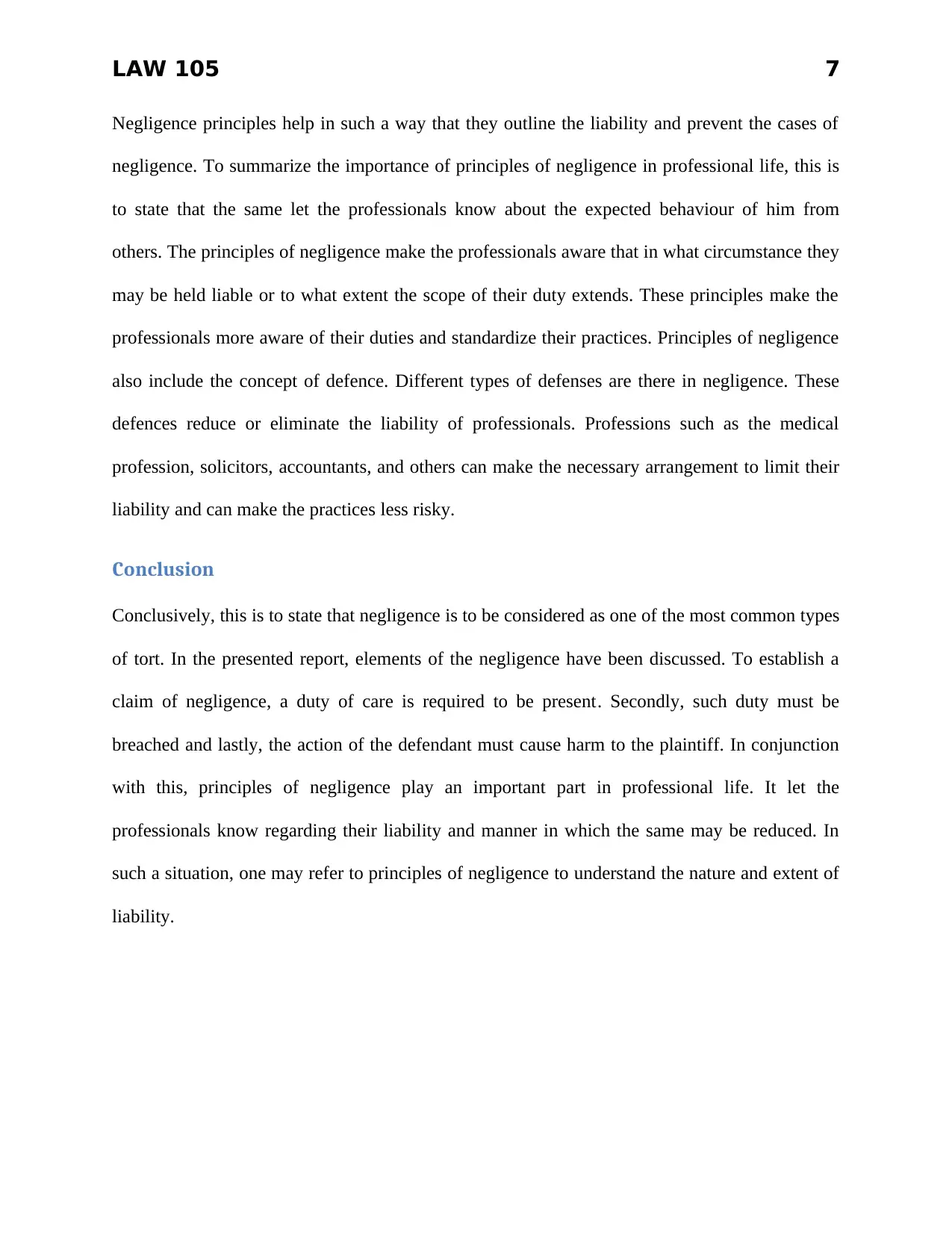
LAW 105 7
Negligence principles help in such a way that they outline the liability and prevent the cases of
negligence. To summarize the importance of principles of negligence in professional life, this is
to state that the same let the professionals know about the expected behaviour of him from
others. The principles of negligence make the professionals aware that in what circumstance they
may be held liable or to what extent the scope of their duty extends. These principles make the
professionals more aware of their duties and standardize their practices. Principles of negligence
also include the concept of defence. Different types of defenses are there in negligence. These
defences reduce or eliminate the liability of professionals. Professions such as the medical
profession, solicitors, accountants, and others can make the necessary arrangement to limit their
liability and can make the practices less risky.
Conclusion
Conclusively, this is to state that negligence is to be considered as one of the most common types
of tort. In the presented report, elements of the negligence have been discussed. To establish a
claim of negligence, a duty of care is required to be present. Secondly, such duty must be
breached and lastly, the action of the defendant must cause harm to the plaintiff. In conjunction
with this, principles of negligence play an important part in professional life. It let the
professionals know regarding their liability and manner in which the same may be reduced. In
such a situation, one may refer to principles of negligence to understand the nature and extent of
liability.
Negligence principles help in such a way that they outline the liability and prevent the cases of
negligence. To summarize the importance of principles of negligence in professional life, this is
to state that the same let the professionals know about the expected behaviour of him from
others. The principles of negligence make the professionals aware that in what circumstance they
may be held liable or to what extent the scope of their duty extends. These principles make the
professionals more aware of their duties and standardize their practices. Principles of negligence
also include the concept of defence. Different types of defenses are there in negligence. These
defences reduce or eliminate the liability of professionals. Professions such as the medical
profession, solicitors, accountants, and others can make the necessary arrangement to limit their
liability and can make the practices less risky.
Conclusion
Conclusively, this is to state that negligence is to be considered as one of the most common types
of tort. In the presented report, elements of the negligence have been discussed. To establish a
claim of negligence, a duty of care is required to be present. Secondly, such duty must be
breached and lastly, the action of the defendant must cause harm to the plaintiff. In conjunction
with this, principles of negligence play an important part in professional life. It let the
professionals know regarding their liability and manner in which the same may be reduced. In
such a situation, one may refer to principles of negligence to understand the nature and extent of
liability.
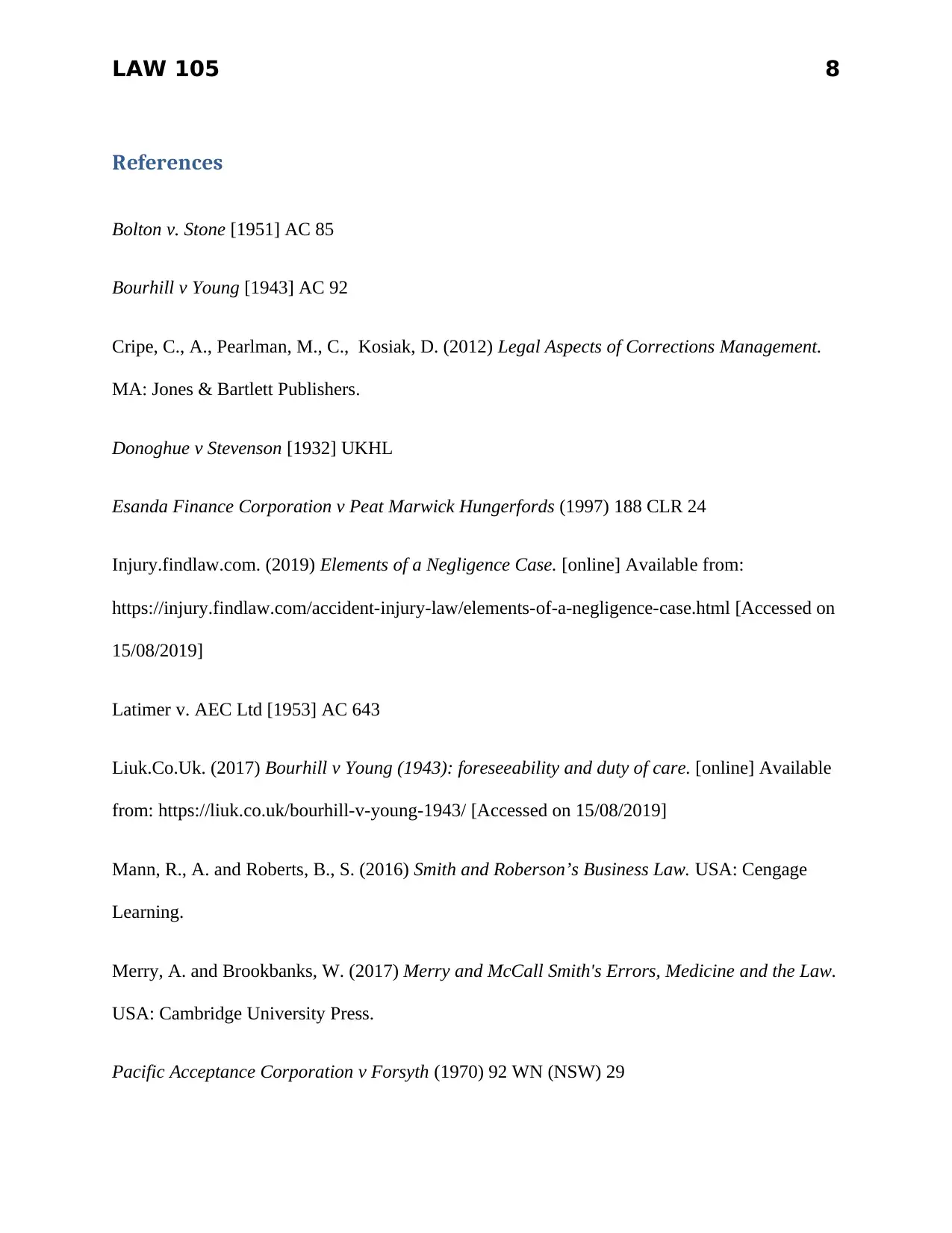
LAW 105 8
References
Bolton v. Stone [1951] AC 85
Bourhill v Young [1943] AC 92
Cripe, C., A., Pearlman, M., C., Kosiak, D. (2012) Legal Aspects of Corrections Management.
MA: Jones & Bartlett Publishers.
Donoghue v Stevenson [1932] UKHL
Esanda Finance Corporation v Peat Marwick Hungerfords (1997) 188 CLR 24
Injury.findlaw.com. (2019) Elements of a Negligence Case. [online] Available from:
https://injury.findlaw.com/accident-injury-law/elements-of-a-negligence-case.html [Accessed on
15/08/2019]
Latimer v. AEC Ltd [1953] AC 643
Liuk.Co.Uk. (2017) Bourhill v Young (1943): foreseeability and duty of care. [online] Available
from: https://liuk.co.uk/bourhill-v-young-1943/ [Accessed on 15/08/2019]
Mann, R., A. and Roberts, B., S. (2016) Smith and Roberson’s Business Law. USA: Cengage
Learning.
Merry, A. and Brookbanks, W. (2017) Merry and McCall Smith's Errors, Medicine and the Law.
USA: Cambridge University Press.
Pacific Acceptance Corporation v Forsyth (1970) 92 WN (NSW) 29
References
Bolton v. Stone [1951] AC 85
Bourhill v Young [1943] AC 92
Cripe, C., A., Pearlman, M., C., Kosiak, D. (2012) Legal Aspects of Corrections Management.
MA: Jones & Bartlett Publishers.
Donoghue v Stevenson [1932] UKHL
Esanda Finance Corporation v Peat Marwick Hungerfords (1997) 188 CLR 24
Injury.findlaw.com. (2019) Elements of a Negligence Case. [online] Available from:
https://injury.findlaw.com/accident-injury-law/elements-of-a-negligence-case.html [Accessed on
15/08/2019]
Latimer v. AEC Ltd [1953] AC 643
Liuk.Co.Uk. (2017) Bourhill v Young (1943): foreseeability and duty of care. [online] Available
from: https://liuk.co.uk/bourhill-v-young-1943/ [Accessed on 15/08/2019]
Mann, R., A. and Roberts, B., S. (2016) Smith and Roberson’s Business Law. USA: Cengage
Learning.
Merry, A. and Brookbanks, W. (2017) Merry and McCall Smith's Errors, Medicine and the Law.
USA: Cambridge University Press.
Pacific Acceptance Corporation v Forsyth (1970) 92 WN (NSW) 29
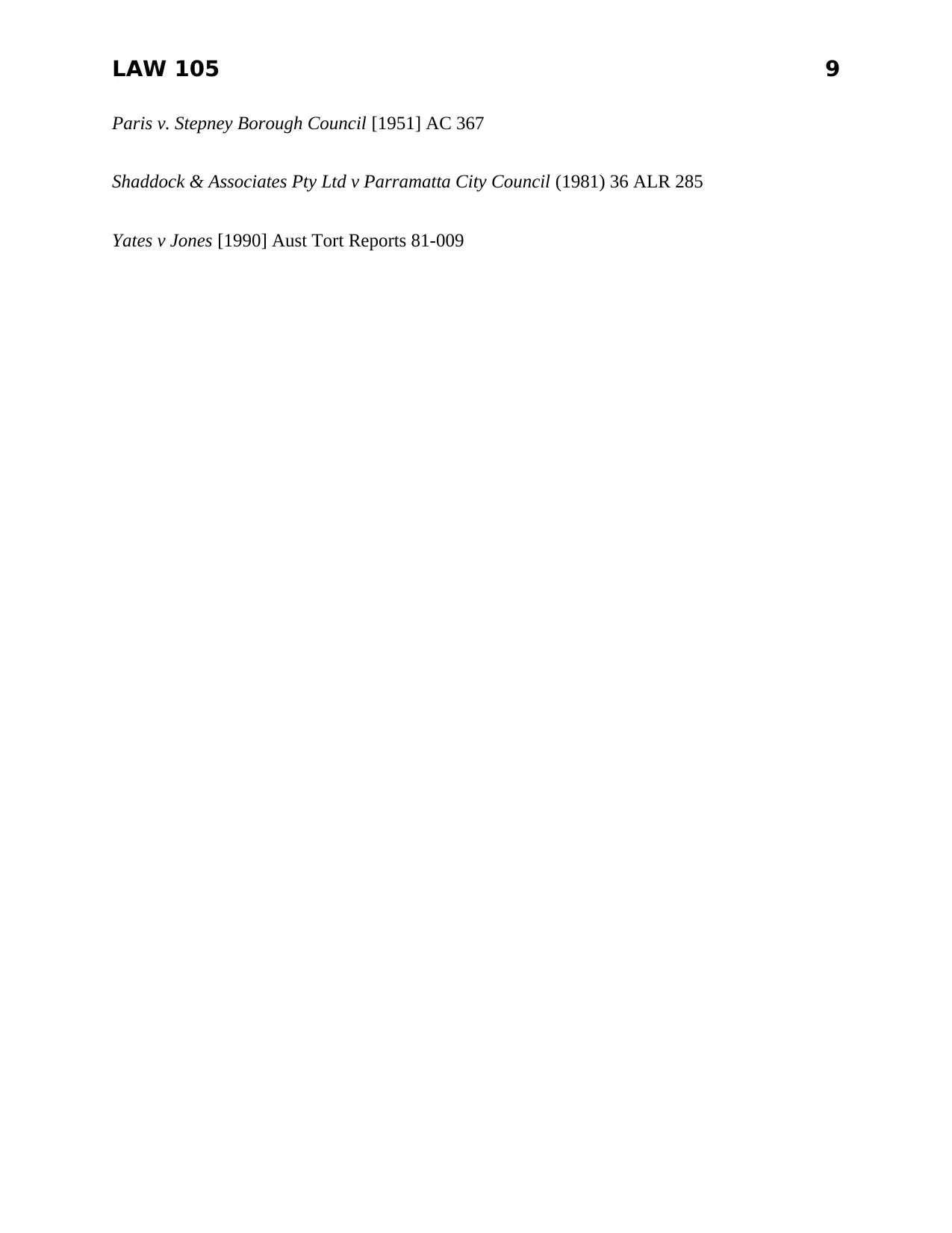
LAW 105 9
Paris v. Stepney Borough Council [1951] AC 367
Shaddock & Associates Pty Ltd v Parramatta City Council (1981) 36 ALR 285
Yates v Jones [1990] Aust Tort Reports 81-009
Paris v. Stepney Borough Council [1951] AC 367
Shaddock & Associates Pty Ltd v Parramatta City Council (1981) 36 ALR 285
Yates v Jones [1990] Aust Tort Reports 81-009
1 out of 10
Related Documents
Your All-in-One AI-Powered Toolkit for Academic Success.
+13062052269
info@desklib.com
Available 24*7 on WhatsApp / Email
![[object Object]](/_next/static/media/star-bottom.7253800d.svg)
Unlock your academic potential
© 2024 | Zucol Services PVT LTD | All rights reserved.





